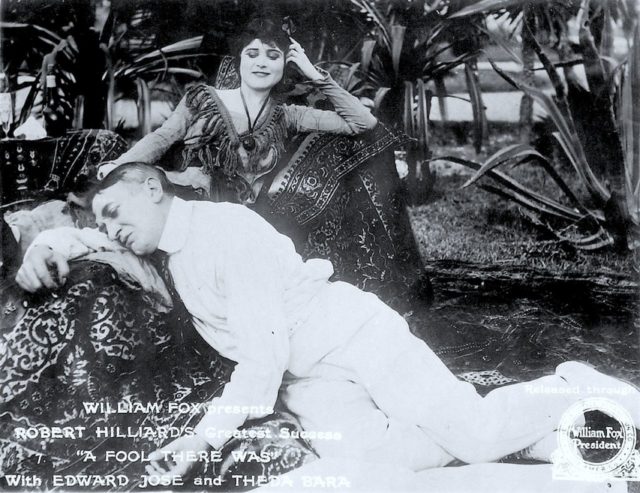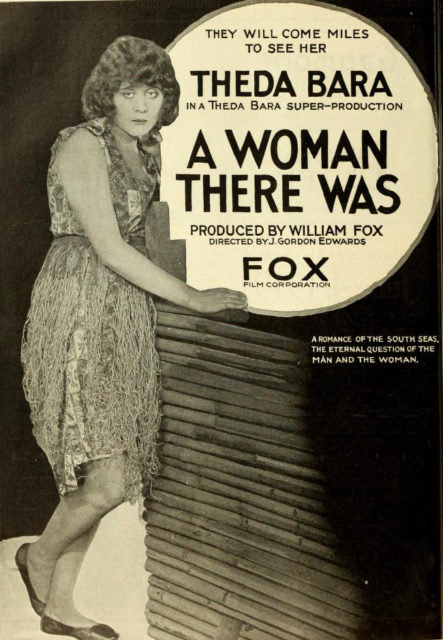Starting in the nineteenth century, vampires assailed our imaginations through popular fiction and over the years they became part of our pop culture. The night stalkers with an appetite for human blood have been part of countless legends. These disturbing supernatural beings continue to frighten and fascinate people all over the world.
Out of the many novels written on the subject, Bram Stoker’s Dracula, published in 1897, is undoubtedly the one that provided the basis for the modern vampire as we all recognize today in films, TV series, and novels. Over the years, Count Dracula has become one of the few fictional characters to appear in over 100 movies.
While we all gladly remember legendary actors such as Max Schreck, Bela Lugosi, and of course, Christopher Lee, who masterfully portrayed the famous Count Dracula, the silver-screen “vamp” was created much earlier. To the surprise of many, the epitomé of the “vamp” persona in Hollywood movies was not a caped actor but actually an actress who went by the name of Theda Bara.

Although nowadays Theda Bara is far from a household name, she was actually one of Hollywood’s most popular actresses in the early years of cinema. Her acting career was brief but notable, as she appeared in more than 40 silent movies in a period of just 12 years. Sadly, most of her films were lost, but the 1915 silent film A Fool There Was, in which Theda Bara portrays the Vampire, still exists, and two years ago it was selected for preservation by the United States Library of Congress.

Born Theodosia Goodman on July 29, 1890, into a family of Jewish immigrants in Cincinnati, Theda Bara dreamed of becoming an actress, and at the age of 18, she went to New York City, hoping to make her dream a reality.

She struggled at the beginning with little success, but her luck changed in 1915, when director Frank Powell cast her for the role of the seductive Vampire in A Fool There Was. The film would turn her world upside-down, making her an overnight sensation and the first Hollywood “vamp,” as it was this nickname for Bara’s character that coined the term.

Fans loved the new exotic–and erotic–actress; in fact, they loved her so much that she allegedly received over 1,000 marriage proposals. Countless songs have been written about her and many children were named Theda in her honor. As written by the Guardian‘s Kira Cochrane, there was also “a perfume and even a sandwich (minced ham, mayonnaise, sliced pimento and sweet pickles on toast served warm) created in her honor.”

Part of her success story is the incredible marketing strategy created by the Fox studio, which includes her fabricated screen name, Theda Bara (supposedly an anagram for “Arab death”), rather mysterious origins, and vampirish personality. According to the studio, she wasn’t born in Cincinnati, Ohio, nor into a family of Jewish immigrants, but to a French actress and an Italian sculptor. The public apparently bought the story and success was inevitable for the then 29-year-old actress.

During the next few years, she went on to star in more than 40 movies, adding details to her vamp image. She became far more than just Hollywood’s first “vamp” and is now considered by many to be the first true sex symbol in the history of Hollywood.

However, her reign as queen of the vamps was sadly short-lived as her contract was dropped by Fox in 1919, meaning that her acting career was virtually over. Vamps were no longer in vogue, and Hollywood was now hunting innocent faces such as Mary Pickford and Marguerite Clark, which meant that Theda Bara was out of the game.

She made several attempts to resurrect her Hollywood career but ended up parodying the vamp image she worked so hard to create. In 1921, Bara married director-writer Charles Brabin, with whom she spent the rest of her life.
Read another story from us: The first Hollywood male sex symbol was Japanese actor Sessue Hayakawa
After 1926, she no longer made attempts to regain her star status, and she never appeared in a sound film. The queen of the vamps left this world on April 7, 1955, dying in Los Angeles at the age of 69.
